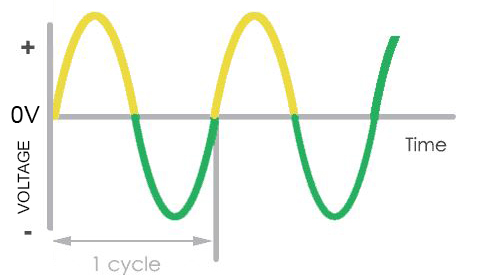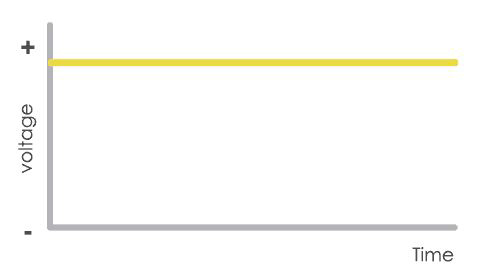Introduction:Although most of our everyday devices require DC power, the power distribution system is essentially the same as it was about 100 years ago and still distributes AC power.
DC lighting refers to the use of direct current (DC) power to illuminate DC lighting fixtures (such as LED lighting). A good example of a DC power distribution system for lighting is PoE (Power over Ethernet), which converts alternating current (AC) power to DC power and distributes it to DC lighting.
How will DC lighting take over the lighting industry?
AC power supply issues for DC lighting
DC lights such as LED fixtures should be supplied with DC power from a DC power supply. Unfortunately, what they usually get is AC power (because the grid distributes AC power). This means that LED fixtures and other DC lighting need to convert the AC power they receive into the required DC power. The rectifiers that perform these AC to DC conversions are quite inefficient, often wasting up to 20% of energy each time the light fixture is turned on.
This energy is wasted in the form of heat, which especially affects DC luminaires if the driver is integrated. When integrating a driver for an LED luminaire, the LEDs and their rectifiers (located inside the driver) are in close proximity. As a result, when energy is wasted as heat through an inefficient rectifier, the heat dissipated is very close to that of the actual device, making LED luminaires with integrated drivers more susceptible to problems caused by thermal runaway.
Thermal runaway is a phenomenon that occurs when heat from inefficient integrated drives begins to wear down the device, creating more inefficiencies in a positive feedback loop. This ultimately accelerates the aging of LED luminaires with integrated drivers (and rectifiers).
the result is:
★Energy inefficiency increases lighting operating costs
★Need to replace LED fixtures more frequently
★flashing lights
The problem with using
Alternating current had its moment of glory when electricity was widely used in the early 20th century. At the time, incandescent lighting was virtually the only option, although only about 2% of the energy emitted by incandescent lighting was used as visible light, with the remaining 98% being wasted as heat. Like most electrical devices of the time, incandescent lamps ran on AC power. Therefore, it is appropriate to distribute air conditioners to homes and buildings.
Now, however, in homes using electric vehicles and HVAC equipment with DC motors, DC consumption accounts for approximately 74% of the total electrical load. Virtually every device that runs on batteries or has a screen requires DC power. Think about your laptop, phone, tablet, camera, and anything else that can be considered digital. Although most of our everyday devices require DC power, the power distribution system is essentially the same as it was about 100 years ago and still distributes AC power.
Of course, there are more technical reasons for choosing AC over DC in the battle of currents.
Benefits of Distributing DC Power to DC Lighting
LEDs are today's most efficient lighting options, typically converting approximately 95% of energy consumed into visible light, with only approximately 5% wasted as heat. As mentioned earlier, LED lighting can be made more efficient by providing it with the required DC power so that inefficient AC to DC conversion is not required. This also minimizes thermal runaway, thus maximizing LED life. Lamp life. Additionally, there are many more benefits to distributing DC power to DC lighting.
1) Eliminate inefficient AC to DC conversion: As mentioned before, when LED fixtures receive AC power, they need to convert the AC power to DC power. Conversion of AC to DC is performed by a rectifier within the light fixture driver. If the driver is integrated, the inefficiency is dissipated in the form of heat, heating the luminaire's electronics. This heat wears down electronics, making them less efficient, which means more heat is emitted and the electronics wear out faster. This positive feedback loop is called thermal runaway. Distributing DC power directly to LED lighting eliminates the need for these inefficient rectifiers, typically reducing DC lighting energy consumption by approximately 20%. It also allows LED lighting to continue operating throughout the lifetime of its LED chip, which is typically around 100,000 hours.
2) Minimized driver performance degradation due to thermal runaway, improving reliability of DC equipment: To jump off the previous point, LEDs that are directly distributed with DC power have a longer lifespan. Two specific benefits of this are that LED fixtures don't need to be replaced as often and they don't flicker.
3) The most energy-efficient devices typically require DC power to operate: Distributing DC power can support the proliferation of energy-efficient technologies because they typically require DC power to operate. Here are some examples of energy-saving options for three different markets. Each of these requires DC power:
★LED lighting
★Variable Speed HVAC Equipment: This modern HVAC system uses approximately 15% less energy than a single-stage unit because it does not always operate at its maximum capacity.
★EV DC-Level Fast Charging: Level 3 EV chargers provide DC power to EV batteries (which require DC power to operate). They charge electric vehicles about 10 times faster than Level 2 chargers. We made a full video about this which you can see below.
How will DC lighting take over the lighting industry?
4) Smart systems and devices often require DC power to operate: The world is moving towards smarter phones, refrigerators, door locks, TVs, cars, etc., and there are huge opportunities for energy savings when using smart devices and systems. For example, you can automatically adjust lighting brightness according to the availability of natural light (daylight harvesting), and if motorized curtains are also automated, you can save up to 70% of lighting. The smart bulbs and fixtures used in these systems are typically LEDs because of their flexibility and energy efficiency advantages over fluorescent lights. Therefore, lighting in smart systems often requires DC power. Additionally, smart devices are digital devices and therefore use semiconductors, which also require DC power to operate.
5 ) Less dangerous exposure to DC power: Due to the nature of AC power, it can more easily attack our nervous system by penetrating our skin (skin is an insulator with resistive, capacitive and inductive properties) . DC, on the other hand, is still dangerous at certain voltages, but cannot easily penetrate our skin because it has no frequency and is therefore blocked by our body's capacitance. Therefore, AC power is not as safe as DC power at the same voltage .
6 ) DC lighting can become a tailwind for the spread of renewable energy sources such as solar energy: the more devices that use DC power, the greater the demand for DC power generation. While traditional energy sources such as hydroelectric, nuclear and coal-fired power plants produce alternating current electricity, more renewable energy sources such as solar energy produce direct current electricity. When alternating current is generated but needs to be converted to direct current, large rectification equipment is required, which results in extremely high transmission costs. One way to reduce the cost of this equipment is to directly use solar energy to generate DC electricity.
Currently, there are technical challenges that prevent large-scale solar power generation. For example, storage and voltage regulation technology are not yet at the point where high-voltage direct current can be generated, stored and, if necessary, stepped down. To explain further, AC power is compatible with transformers, while DC power is not. Transformers are devices that can easily step up or step down the voltage depending on the voltage requirements, and they can also isolate electricity for safety.
In order to use DC power in a transmission system, a rectifier must be used to convert the DC power into AC power and then step up or step down (using a transformer). It can then be converted back to DC. Therefore, 1 - 2 large rectifiers are required in HVDC transmission, depending on whether the AC power needs to be converted back to DC afterwards. Due to the high efficiency with which DC current travels through cables, the cost of this additional equipment is usually justified, but only over "break-even" distances (approximately 600 km).
Currently, direct current can be more practically generated and distributed on a much smaller scale. Solar panels are commonly found on the roofs of buildings such as schools and offices. These DC microgrids can sustainably supply energy and can also provide the required DC power for DC devices such as LED lighting. If more people decide to distribute DC power to their DC lighting, this could be one of the driving factors for the proliferation of renewable energy sources such as solar energy, even if it is currently only used for small-scale power generation.
Despite the challenges of large-scale DC generation and transmission, small-scale DC distribution has made great progress recently.
The essential difference between AC power and DC power
Maybe you're wondering what the difference is between AC power and DC power. The fundamental difference between the two is the direction in which the current flows; DC power travels in a straight path on a voltage versus time graph, while AC power alternates polarity 50 - 60 times per second. This gives the alternating current a frequency, and frequency has both negative and positive consequences.
On the one hand, having frequency means that AC is compatible with transformers, which often makes it cheap to step up voltage for long distance transmission. In fact, this is why the battle of currents ultimately settled on AC power. On the other hand, the frequency makes it more prone to line losses than DC supplies. Since DC power has no frequency, it is not prone to any line losses other than some types of resistive line losses. This makes it cheaper to use HVDC systems after the breakeven distance reaches 600 km (as mentioned earlier).

Summarize
In conclusion, providing the required DC power for DC lighting is a method that is rapidly gaining attention due to its advantages such as efficiency. AC lighting, such as incandescent bulbs, is significantly less efficient than DC lighting, such as LEDs, and supplying AC power to DC lighting reduces the energy efficiency of DC lighting. Eliminating AC-to-DC conversion in DC lighting using DC microgrids or other forms of DC distribution can improve energy efficiency and minimize thermal runaway. This not only saves costs but also contributes to a more sustainable future by minimizing lighting energy waste.
The rise of smart lighting, which also relies on DC power, further highlights the advantages of DC lighting and enables advanced control, automation and energy management functions. In addition, DC lighting can serve as a tailwind for renewable energy generation, particularly solar power. Since solar panels generate DC electricity, using them in conjunction with DC lighting systems can simplify the overall energy infrastructure and promote the use of clean and renewable energy. As we move towards a greener, smarter future, DC lighting has huge potential to change the way we light our spaces.
- LanguageEnglish 正體中文
- My account

